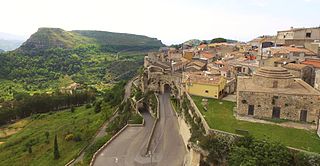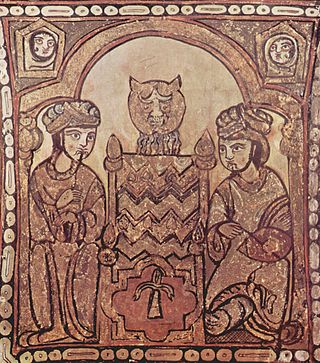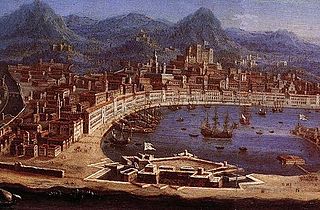
Sicily is an island in the central Mediterranean Sea, south of the Italian Peninsula in continental Europe and is one of the 20 regions of Italy. With 4.8 million inhabitants, including 1.3 million in and around the capital city of Palermo, it is the most populous island in the Mediterranean Sea. It is named after the Sicels, who inhabited the eastern part of the island during the Iron Age. Sicily has a rich and unique culture in arts, music, literature, cuisine, and architecture. Its most prominent landmark is Mount Etna, the tallest active volcano in Europe, and one of the most active in the world, currently 3,357 m (11,014 ft) high. The island has a typical Mediterranean climate. It is separated from Calabria by the Strait of Messina. It is one of the five Italian autonomous regions and is generally considered part of Southern Italy.
Messina is the third largest city in Sicily.

Reggio di Calabria, commonly and officially referred to as Reggio Calabria, or simply Reggio by its inhabitants, is the largest city in Calabria as well as the seat of the Regional Council of Calabria. It has an estimated population between 150,000 and 200,000 and is the twenty-first most populous city in Italy, after Modena and other Italian cities, and the 100th most populated city in Europe. Reggio Calabria is located near the center of the Mediterranean and is known for its climate, ethnic and cultural diversity. It is the third economic centre of mainland Southern Italy. About 560,000 people live in the metropolitan area, recognised in 2015 by Italy as a metropolitan city. Sadly, it holds the record of the worst city in terms of quality of life for environmental and cultural parameters, ranking among the worst Italian cities for quality of life.

Marsala is an Italian comune located in the Province of Trapani in the westernmost part of Sicily. Marsala is the most populated town in its province and the fifth largest in Sicily.

Messina is a harbour city and the capital of the Italian Metropolitan City of Messina. It is the third largest city on the island of Sicily, and the 13th largest city in Italy, with a population of more than 218,000 inhabitants in the city proper and about 650,000 in the Metropolitan City. It is located near the northeast corner of Sicily, at the Strait of Messina and it is an important access terminal to Calabria region, Villa San Giovanni, Reggio Calabria on the mainland. According to Eurostat the FUA of the metropolitan area of Messina has, in 2014, 277,584 inhabitants.
Siege of Jerusalem, fall of Jerusalem, or sack of Jerusalem may refer to:

Djibo is a town in northern Burkina Faso and the capital city of Soum Province. It is situated 203 km (126 mi) north of Ouagadougou and 45 km (28 mi) from the border with Mali. It was founded in the 16th century and became the capital of Djilgodji, before becoming dominated by the Messina Empire in the 19th century. It is known for its animal market. The main ethnic group is the Fulani.

Sicilia was the first province acquired by the Roman Republic, encompassing the island of Sicily. The western part of the island was brought under Roman control in 241 BC at the conclusion of the First Punic War with Carthage. A praetor was regularly assigned to the island from c. 227 BC. The Kingdom of Syracuse under Hieron II remained an independent ally of Rome until its defeat in 212 BC during the Second Punic War. Thereafter the province included the whole of the island of Sicily, the island of Malta, and the smaller island groups.

The Sicilian revolution of independence of 1848 which commenced on 12 January 1848 was the first of the numerous Revolutions of 1848 which swept across Europe. It was a popular rebellion against the rule of Ferdinand II of the House of Bourbon, King of the Two Sicilies. Three revolutions against the Bourbon ruled Kingdom of the Two Sicilies had previously occurred on the island of Sicily starting from 1800: this final one resulted in an independent state which survived for 16 months. The Sicilian Constitution of 1848 which survived the 16 months was advanced for its time in liberal democratic terms, as was the proposal of a unified Italian confederation of states. It was in effect a curtain-raiser to the end of the Bourbon kingdom of the Two Sicilies, finally completed by Giuseppe Garibaldi's Expedition of the Thousand in 1860, the Siege of Gaeta of 1860–1861 and the proclamation of the unified Kingdom of Italy.

Rometta is a comune (municipality) in the Metropolitan City of Messina in the Italian region Sicily, located about 180 kilometres (110 mi) east of Palermo and about 12 kilometres (7 mi) west of Messina. It was the last bastion of Sicily controlled by the Eastern Roman Empire (Byzantium), and falling only in 965 to the Kalbids' Muslim army in the Siege of Rometta.

Torregrotta is a small town and municipality (comune) in the Metropolitan City of Messina in the Italian region Sicily, located about 170 kilometres (110 mi) east of Palermo and about 30 kilometres (19 mi) west of Messina.

The Sicilian Wars, or Greco-Punic Wars, were a series of conflicts fought between ancient Carthage and the Greek city-states led by Syracuse over control of Sicily and the western Mediterranean between 580 and 265 BC.

The history of Islam in Sicily and southern Italy began with Arab colonization in Sicily, at Mazara, which was captured in 827. The subsequent rule of Sicily and Malta started in the 10th century. The Emirate of Sicily lasted from 831 until 1061, and controlled the whole island by 902. Though Sicily was the primary Muslim stronghold in Italy, some temporary footholds, the most substantial of which was the port city of Bari, were established on the mainland peninsula, especially in mainland southern Italy, though Arab raids, mainly those of Muhammad I ibn al-Aghlab, reached as far north as Naples, Rome and the northern region of Piedmont. The Arab raids were part of a larger struggle for power in Italy and Europe, with Christian Byzantine, Frankish, Norman and indigenous Italian forces also competing for control. Arabs were sometimes allied with various Christian factions against other factions.

A devastating earthquake occurred on 28 December 1908 in Sicily and Calabria, southern Italy with a moment magnitude of 7.1 and a maximum Mercalli intensity of XI (Extreme). The epicentre was in the Strait of Messina which separates Sicily from the Italian mainland. The cities of Messina and Reggio Calabria were almost completely destroyed and between 75,000 and 82,000 people died, making it the deadliest earthquake in the history of Europe.

Antonio Ferramolino was a 16th-century Italian architect and military engineer. He is also known as Sferrandino da Bergamo, and is called Hernan Molin in Spanish sources. He is mostly known for his work in Sicily, but he also designed fortifications in Ragusa and Malta.

The Real Cittadella was a fort in Messina, Sicily. The Cittadella was built between 1680 and 1686 by the Spanish Empire, and it was considered to be one of the most important fortifications in the Mediterranean. Most of the fort was demolished in the 20th century, but some parts can still be seen.

The fortifications of Messina were a series of defensive walls and other fortifications which surrounded the city of Messina, Sicily. The first walls were built during the Middle Ages in around 1200. A system of bastioned fortifications was constructed around the city in the 1530s and 1540s. The fortifications were modified over the years, with the last major addition being the Real Cittadella, which was built in the 1680s. Most of the walls were demolished in the 19th and 20th centuries, but some parts of the walls still survive today.
The following is a timeline of the history of the city of Messina, Sicily, Italy.

Dina and Clarenza are two women connected in legend with the historical siege of Messina by Charles I of Anjou during the Sicilian Vespers in August 1282.
The Siege of Rometta was a successful siege of the Byzantine city of Rometta, in northeastern Sicily, by the Kalbids on behalf of the Fatimid Dynasty, that took place between 963 and 965 and marked the conclusion of the Muslim conquest of Sicily.















